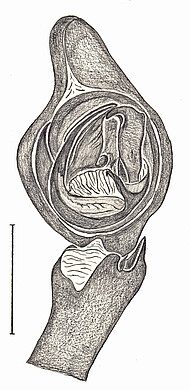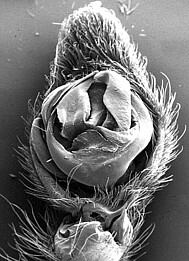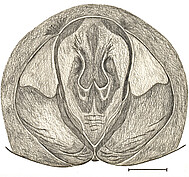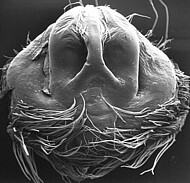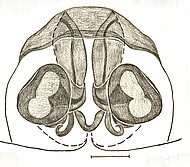Ancylometes concolor (♂,♀) (Perty, 1833)
transfers and synonyms
Aranea unicolor: Lamarck 1818 (nomen nudum)
Dolomedes concolor Perty, 1833; synonym of Ctenus unicolor
Ctenus unicolor Walckenaer, 1837
Ctenus concolor C.L. Koch, 1837; 1847
Ancylometes vulpes Bertkau, 1880; Roewer 1954; Bonnet 1955; Bernarde et al. 1999:200, fig.3
Ctenus argentinus Holmberg, 1881
Lycoctenus concolor: Pickard-Cambridge, 1897
Ancylometes bolivianus Tullgren, 1905; Roewer 1954; Bonnet 1955; Schiapelli & Gerschmann de Pikelin 1970 (as synonym of A. bogotensis)
Lycoctenus bahiensis Strand, 1909
Lycoctenus selenkae Strand, 1909; 1909
Lycoctenus paraguayensis Strand, 1909; 1909
Cupiennius argentinus Petrunkevitch, 1911; Lucas 1964 (as synonym of A. bogotensis)
Ancylometes paraguayensis: Petrunkevitch 1911; Roewer 1954; Bonnet 1955
Ancylometes bayensis: Roewer 1954; Bonnet 1955
Ancylometes selenkaev: Petrunkevitch 1911; Roewer 1954; Bonnet 1955
Ctenus paulensis Mello-Leitão, 1922; Roewer 1954; Bonnet 1956
Cupiennius diplocellatus Mello-Leitão, 1936; Roewer 1954; Lucas 1964 (as synonym of A. bogotensis)
Ctenus originalis Mello-Leitão, 1936; Roewer 1954; Lucas 1964 (as synonym of A. bogotensis)
Ctenus iophorus Mello-Leitão, 1937; Roewer 1954; Bonnet 1956
Corinoctenus anomalostomus Mello-Leitão, 1939; Roewer 1954; Carcavallo & Martinez 1960 (description of male); Schiapelli & Gerschmann de Pikelin 1970(as synonym of A. bogotensis)
Ctenus infelix Mello-Leitão, 1940; Roewer 1954
Ctenus metatarsalis Mello-Leitão, 1941; Roewer 1954; Schiapelli & Gerschmann de Pikelin 1970 (as synonym of A. bogotensis) )
Phoneutria niveobarbata Mello-Leitão, 1945; Schiapelli & Gerschmann de Pikelin 1972 (as synonym of A. bogotensis) )
Ancylometes concolor : Bonnet 1955
Corinoctenus greenwayi Carcavallo & Martinez, 1960; 1960 (description of female); Schiapelli & Gerschmann de Pikelin 1970(as synonym of A. bogotensis)
distribution
Southern to central South America: Bolivia (Beni), Brazil, Argentina, Paraguay
description male
(specimen deposited at SMNK 1448):
Prosoma dorsally dark brown with median band of yellow hairs and broad marginal bands of white hairs, both linked by diverging white stripes. Chelicerae with white hairs near base. Abdomen and legs light brown. Metatarsi I and II dorsally densely covered by white hairs, Metatarsi III and all tibiae irregularly spotted by white hairs. Ventral parts of body generally lighter, abdomen more reddish. Chelicerae with 3 unequal promarginal and 4 subequal retromarginal teeth.
Palpal tibia with curved ventral and black lateral apophysis. Embolus broad at base, flanked by rounded membraneous lobe and describing semicircle, ending filiform beneath apex of cymbium, median part embedded in wing-like conductor. Opposite to conductor straight hammer-like median apophysis.
Measurements: Total length 20.0. Prosoma 11.6 long, 10.0 wide, 3.5 high. Clypeus 0.7.
Eye diameters and interdistances: AME 0.45, ALE 0.25, PME 0.5, PLE 0.45; AME-AME 0.25, AME-ALE 0.45, PME-PME 0.25, PME-PLE 0.5, AME-PLE 0.8, AME-PME 0.35, MOQ length 1.25, front width 1.1, back width 1.3.
Legs. I-femur 12.0/ patella 5.0/ tibia 12.0/ metatarsus 11.0/ tarsus 6.5/ total 47.0; II- 11.0/ 5.0/ 11.0/ 10.0/ 6.0/ 43.0; III- 10.0/ 4.0/ 8.0/ 9.0/ 5.0/ 39.0; IV- 12.5/ 5.0/ 11.5/ 14.0/ 6.0/ 49.0. Cymbium 4.0 long, 2.6 wide, median apophysis 1.35 long.
Leg spination: Femora I p1-1-1-1, r1-1-1, d1-1-1; II p1-1-1-1, r1-1-1-1-1, d1-1-1; III p1-1-1-1, r1-1-1-1, d1-1; IV p1-1-1, r(2)-1-1-1, d1-1-1; patellae I-IV p1, r1; tibiae I-II v2-2-2-2, p1-1, r1-1-1, d1-1-1; III-IV v2-2-2, p1-1, r1-1, III d1-1, IV d1-1-1-1; metatarsi I-II v2-2-2, p1-1-1, r1-1-1; III v2-2-2, p1-2-1, r1-2-1; IV v2-1-1-2-2, p1-2-1, r1-2-1; tarsi III-IV v2-2-2-2-2. Palpal femora p1, r1, d1-1-1-2; patellae p1; tibiae p1-1, r1. One male with a row of six spines dorsally on patella of one palp.
Coloration of living specimens (from São Paulo). Males lighter brown, cephalothorax with broad white marginal bands, and obscure diverging bands; abdomen dorsally with dark cardiac mark, 2 pairs of dark spots on anterior half and a pair of light spots on posterior half of abdomen. Metatarsi I and II dorsally whitish. Venter reddish brown with weak light stripes forming a triangle.
description female
(specimen deposited at SMNK 1447):
Whole animal light brown, chelicerae dark brown to black, densely covered by long hairs, cheliceral boss reddish-brown. Abdomen with 2 pairs of dark spots on dorsum and 4 longitudinal lines of small dark spots on venter.
Epigyne: median plate in its anterior part broad rectangular, prominent, with characteristic central triangular protuberance, anterior border rounded or slightly invaginated. Lateral plates broad, meeting the median plate near its anterior border. Epigynal openings situated anteriorly. Copulatory ducts broad and straight, entering spermathecae ventrally. Spermathecae nearly their diameter apart. Chelicerae with 3 unequal promarginal and 4 subequal retromarginal teeth.
Measurements: Total length 32.0. Prosoma 14.9 long, 11.6 wide, 3.5 high. Clypeus 0.9 high. Eye diameters and interdistances: AME 0.5, ALE 0.35, PME 0.6, PLE 0.6; AME-AME 0.5, AME-ALE 0.65, PME-PME 0.35, PME-PLE 0.8, AME-PLE 1.5, AME-PME 0.35, MOQ length 1.4, front width 1.15, back width 1.5. Epigynal median plate 1.5 long, 1.05 wide.
Legs: I-femur 12.0/ patella 7.0/ tibia 9.5/ metatarsus 9.0/ tarsus 5.0/ total 42.5; II- 12.0/ 6.0/ 9.2/ 9.0/ 5.0/ 41.0; III- 10.5/ 5.0/ 9.0/ 9.0/ 5.0/ 38.5; IV- 12.0/ 5.0/ 12.0/ 12.5/ 6.0/ 48.0.
Leg spination: Femora I-II p1-1-1-1, r1-1-1, d1-1-1; III p1-1-1-1, r1-1-1-1, d1-1-1; IV p1-1-1-1, r1, d1-2-2; patellae I p1; II-IV p1, r1; tibiae I-II v2-2-2; III v2-2-2, p1-1, r1-1, d1-1-1; IV v2-2-2, p1-1-1, r1-1-1, d1-1-1; metatarsi I v2-2-1, II v2-2-2, III v2-2-1, p1-1-1, r1-1-1, d1-2-2; IV v2-1-1-2-2, p1-1-1, r1-1-1-1, d2-2-1-2; tarsi III-IV v2-2-2-2-2. Palpal femora p1, r1, d1-1-2; patellae p1; tibiae p1-1, d1; tarsi p2-1, r1.
Coloration of living specimens (from São Paulo): Females generally darker brown. Cephalothorax without white bands, all other patterns less obvious than in males. All metatarsi dark.
comments
Type species of the genus Ancylometes, types lost, redescription by Höfer & Brescovit (2000) on specimens from the type locality (Barbacena, Minas Gerais, Brazil)
references
- Höfer H., Brescovit AD. (2000):
- A revision of the Neotropical spider genus Ancylometes Bertkau (Araneae: Pisauridae). Insect Systematics & Evolution 31
- Bernarde P.S., Barbosa-de-Souza M. & Carvalho-de-Nogueira-Kokubum M. (1999):
- Predation on Hyla minuta Peters, 1872 (Anura, Hylidae) by Ancylometes spp. (Araneae, Pisauridae). Biociências 7
- Bertkau P. (1880):
- Verzeichniss der von Prof. Ed. van Beneden auf seiner im Auftrage der Belgischen Regierung unternommenen wissenschaftlichen Reise nach Brasilien und La Plata i. J. 1872-75 gesammelten Arachniden. Mém. cour. Acad. r. Sci. Belg. 43, Brüssel


